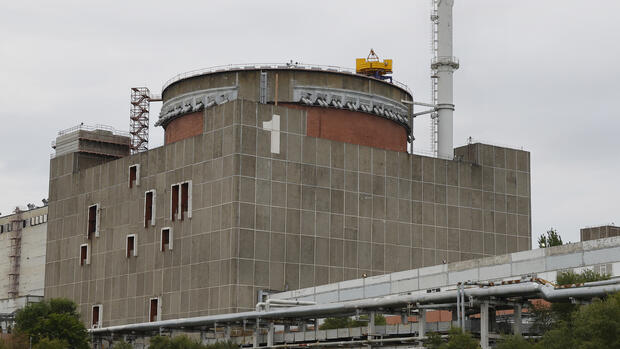The Zaporizhia power plant is under Russian control.
(Photo: dpa)
Berlin, Brussels Ukraine warns of an attack on Europe’s largest nuclear power plant (NPP) in Zaporizhia. “Unfortunately, the world public’s attention to the existing Russian threat at the Zaporizhia nuclear power plant is still insufficient,” said President Volodymyr Zelensky in his address earlier this week.
The power plant is under Russian control. According to the analysts of the Institute for the Study of War (ISW), the occupiers mined the cooling pond of the nuclear power plant and drove vehicles loaded with explosives to four of the six power plant blocks. A sabotage of the power plant could therefore harm the Russian side in the war more than the Ukrainian. Nevertheless, the ISW does not rule out an attack.
Zelensky said Ukraine’s western partners had received all available intelligence information about Russia’s plans for the nuclear power plant: “We must take very concrete measures, all together in the world, to prevent any radiation incidents.”
The allegations from Ukraine cannot be checked. In addition to the mines and explosive charges, there is another danger: the cooling basin could run dry. So far, it has been fed from the adjacent reservoir, which, however, ran dry after the Kachowka Dam was blown up.
Reactors of the Zaporizhia nuclear power plant shut down since September 11, 2022
All six reactors at the Zaporizhia power plant have been shut down since September 11, 2022. A spokeswoman for the Federal Office for Radiation Protection (BfS) recently told the Handelsblatt that the risk of a radiological accident is steadily decreasing because the decay heat of the fuel elements is decreasing.
>> Read also: Cracks in the power base of Kremlin chief Vladimir Putin
Short-lived radioactive substances such as the isotope iodine-131 have also decayed in the meantime. However, the facility still relies on a working power supply for cooling and security systems.
A release of radioactivity could make the area around the power plant uninhabitable. The city of Nikopol, which once had around 100,000 inhabitants, is located on the other side of the Dnieper River, about 50 kilometers away from Zaporizhia.
In extreme cases, radioactivity could be carried to Germany and cause food harvested in this country to exceed the specified values, the BfS announced. Controls of feed and food and any sales bans are possible consequences.
According to the calculations of the BfS, however, “it is not to be expected that further measures such as evacuation, staying in buildings or taking iodine tablets to protect the population in Germany would be necessary”.
>> Read here: War in Ukraine – the developments in the live blog
In Ukraine, however, the consequences could be significant. That depends on the type of accident, the weather and the amount of radioactive material released.
Other cooling options
Earlier studies by the BfS had shown that over the course of a year, the air masses only moved from the Ukraine to Germany in around 17 percent of the cases. In addition, due to the great distance between Ukraine and Germany, it would take at least one to two days in most weather conditions for radioactively contaminated air to reach Germany.
The Society for Reactor Safety (GRS) points out that even in the event of a core meltdown, the amount of radioactivity released would “definitely be well below the amounts known from Fukushima or even Chernobyl”.
>> Read here: After the attempted coup, Russia can no longer be sure of its own troops
Should the cooling pond actually be blown up, the closed cooling circuit would not be directly affected, as only evaporated water would have to be replaced there. Wells on the nuclear power plant site, a nearby water pit or the water system of the adjacent town of Energodar could also be used for this.
Now that the reactors have been shut down for a while, the danger they pose is reduced. Temperatures of 40 to 60 degrees prevailed, GRS estimates. The chain reaction of nuclear fission in the reactors can no longer sustain itself. The coolant is also no longer hotter than 300 degrees, as is the case in normal operation. “Accordingly, less water is needed to cool the reactors,” said a spokesman for GRS.
More: Destroyed dam poses a threat to Europe’s largest nuclear power plant
